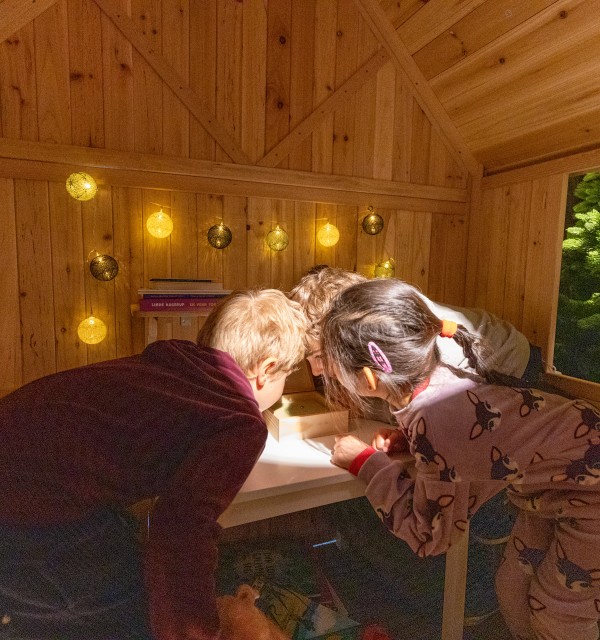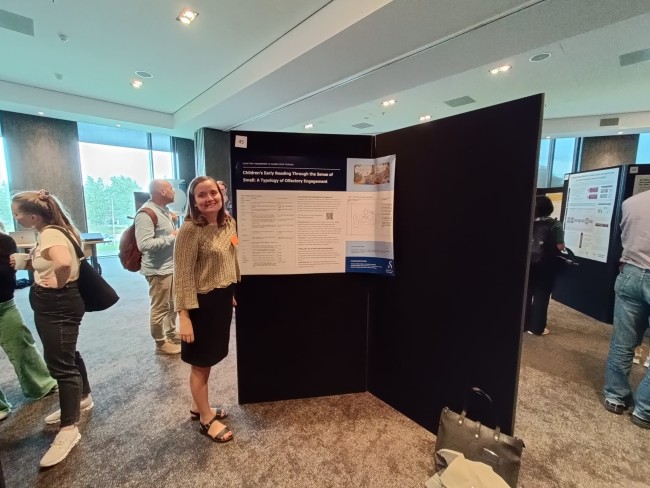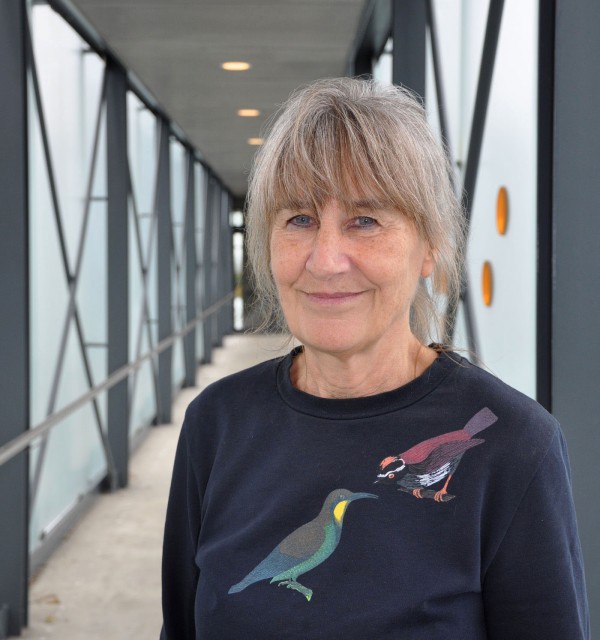This cutting-edge project researches the power of smells and scents to transform children’s reading.
To establish the theoretical mechanisms, methodological innovations and learning benefits of children’s e-books enhanced with sensory stimulation, especially smell
Kindergarten teachers and parent of children age 3-5 years.
2021-2025
About the project
Scents and smells provide unique clues about the environment and they activate interest, engagement, and memories. Yet, the entire educational system relies on audio-visual content and neglects the role of olfaction in children’s learning.
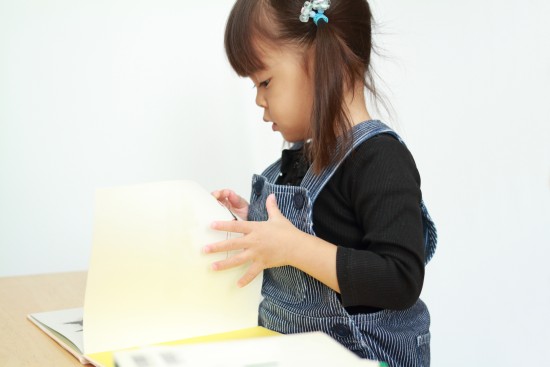
The focus on olfaction carries specific urgency given the current increased use of antiseptics and sanitation products and an altered sense of smell of those who had Covid-19. This is the first project to examine the educational value of olfaction in children’s learning, with a specific focus on children’s reading.
The main study is conducted in Norway, which has one of the world’s highest Internet coverage, technology availability and digital literacy in the educational sector. Data collection follows a participatory research methodology. This means that the researchers involve children as co-researchers, who together with their parents and teachers, examine the role of scents and smells in children’s digital books. The focus is on 3-5-year-old Norwegian children and their schools and families who will find out whether scented books increase children’s reading engagement, comprehension and learning of story-related vocabulary. In addition, children’s authors and illustrators, app designers, publishers and librarians will contribute to the development of prototypes and ideas.
The project combines psychology, education, literary theory and computer science and diverse cutting-edge methods to provide a new perspective on children’s reading in the digital age.
Why are digital books essential for children’s learning?
Many children, especially those labelled as “reluctant readers” prefer to read digitally, or at least they like digital books as much as print books, which affects their intrinsic motivation to read. Unlike print texts, digital texts can be dynamically shared and modified in the process of reading and personalized to the reader. Digital texts are more cost-effective to produce and deliver to readers who don’t have access to reading materials in print and/or in their native language.
Objectives
Well-designed digital books offer significant learning benefits to children with special learning needs and children with little history of reading at home. Therefore, if we are to achieve social justice and promote the reading of all children, it becomes a moral imperative (a matter of social justice) to ensure that children have access digital books. Our project offers children the possibility to experience high-quality digital reading.
Primary objective is to establish the theoretical mechanisms, methodological innovations and learning benefits of children’s e-books enhanced with sensory stimulation, especially smell.
Outcomes and impacts
The project provides the first experimental evidence on the impact of sensory e-reading, with a focus on a novel component: smell. As such, the project brings a much-needed nuanced approach to the under-theorised debates on digital versus paper and cerebral versus embodied reading. A participatory approach will make a difference to how stories are created and perceived by wider public, with focus on parents’ and teachers’ attitudes towards e-reading.
The outcomes include articles and conference presentations of interest to international researchers, national press coverage, blogs, social media campaigns, and empirically grounded guidelines for Norwegian children’s publishers and kindergarten teachers. This pioneering work with e-books and sensory engagement is likely to have a significant impact on Norwegian kindergartens, publishing industry and international knowledge on e-books.
Methodology
The project generate observational and experimental data; building on best practice in RCT interventions and pioneer the use of participatory research methods with childeren's e-reading and sensory experiences. A mixed-method methodology with qualitative and quantitative methodes will be followed.
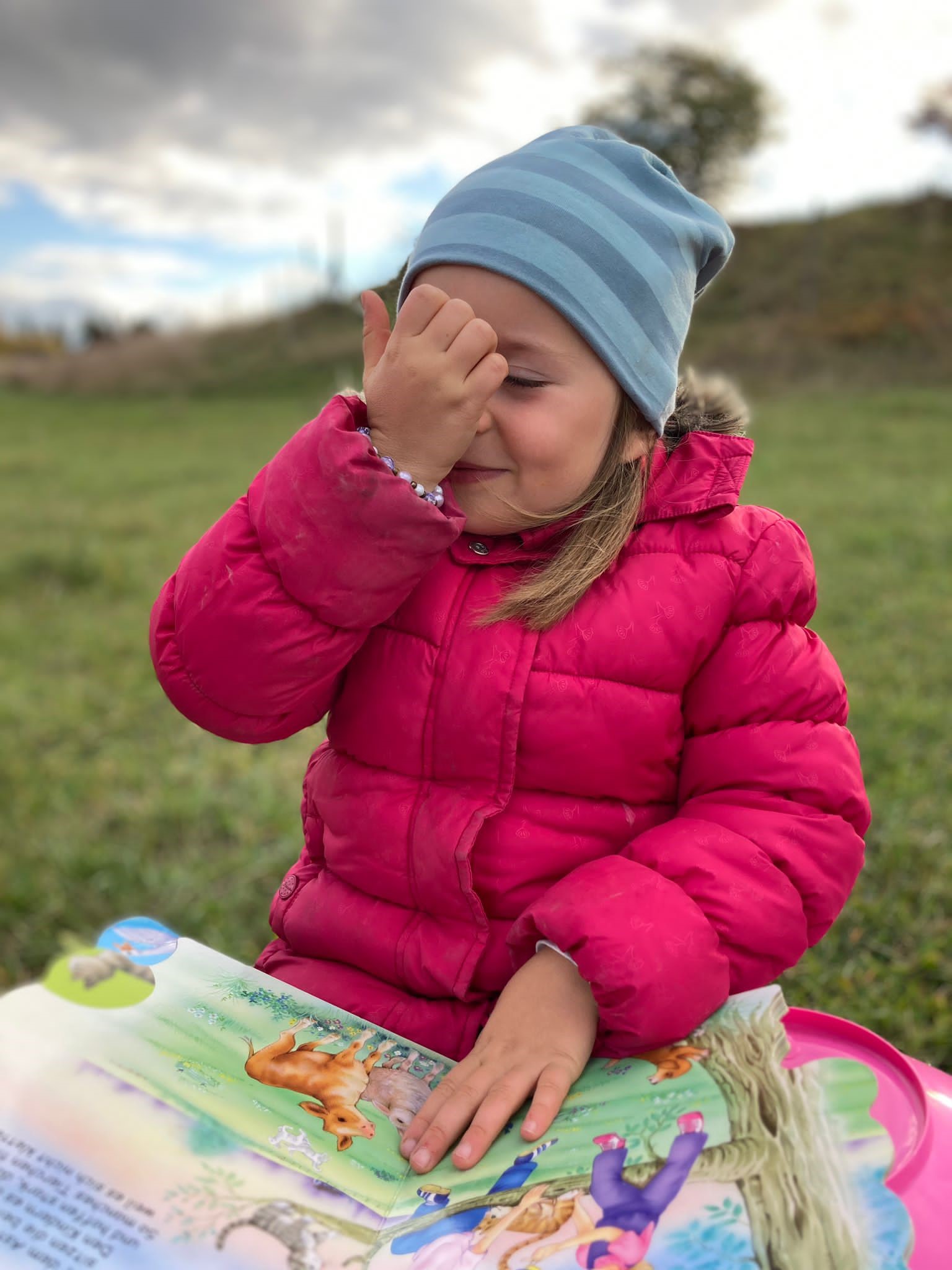
WP1: Meta-analysis
The meta-analysis aims to establish the latest evidence for the use of sensory stimulation (all five senses) as a tool to promote learning. The outcome is precise, quantitative estimates of the size of learning effects of sensory engagement (defined broadly to include all senses), based on a large number of diverse studies. It includes systematic literature review and calculation of effect sizes of published and existing studies/datasets.
WP2: Online national survey
The survey aims to establish Norwegian parents’ and kindergarten teachers’ attitudes towards the connection between children’s story-reading and sensory engagement with e-books. It will produce a comprehensive mapping of the use of e-books in Norwegian families as well as the views of parents and teachers on the ways in which senses influence reading.
WP3: Interactive exhibition with cultural probes
The project team, together with the project partner Vitenfabrikken, organize an interactive exhibition for children living in the local area. The exhibition contain cultural probes, which are a widely used participatory design technique. They consist of kits (with simple materials such as figures, pebbels, feathers, leaves and stickers) distributed to children encouraging them to create their own storyboxes. Cultural probes will be combined with semi-structured contextual interviews to clarify the meaning of children’s artefacts and prompt further reflections.
WP4/WP5: Quantitative experiment
Two experiments will be carried out to evaluate the effectiveness of reading of digital books with and without olfactory stimulation (control condition). The intervention (experimental manipulation) consists of reading digital books provided by the researchers to children to read at home, with and without olfactory stimulation and with and without parents’ help.
WP6: Stakeholder workshops
We will organise workshops with adult professionals to establish their views and ideas on innovative olfactory books.
National survey
As part of the project, a survey has been conducted with the aim of establishing Norwegian parents' and kindergarten teachers' attitudes towards the connection between children's reading of stories and sensory engagement with e-books.

The survey produces a comprehensive mapping of the use of e-books in Norwegian families, as well as the views of parents and teachers on how the senses affect reading.
The survey is a central part of two major Norwegian research projects: SPrELL and Sensory Reading. The SPrELL project focuses on language learning in multilingual children and reading digital texts in multiple languages, while the Sensory Reading project examines the educational value of senses in children's learning, particularly in reading.
You can read more about the findings of the survey in the published articles here:
Shared book reading: a Norwegian survey of reading practices in families
Description of the exhibition The Three Little Pigs - an scented adventure trail
Smell is an important sense that activates memories and enhances experiences. Yet, smell is often neglected in learning and in activities designed for children. Our new exhibition was designed to engage children’s sense of smell in their exploration of the story “The Three Little Pigs”.
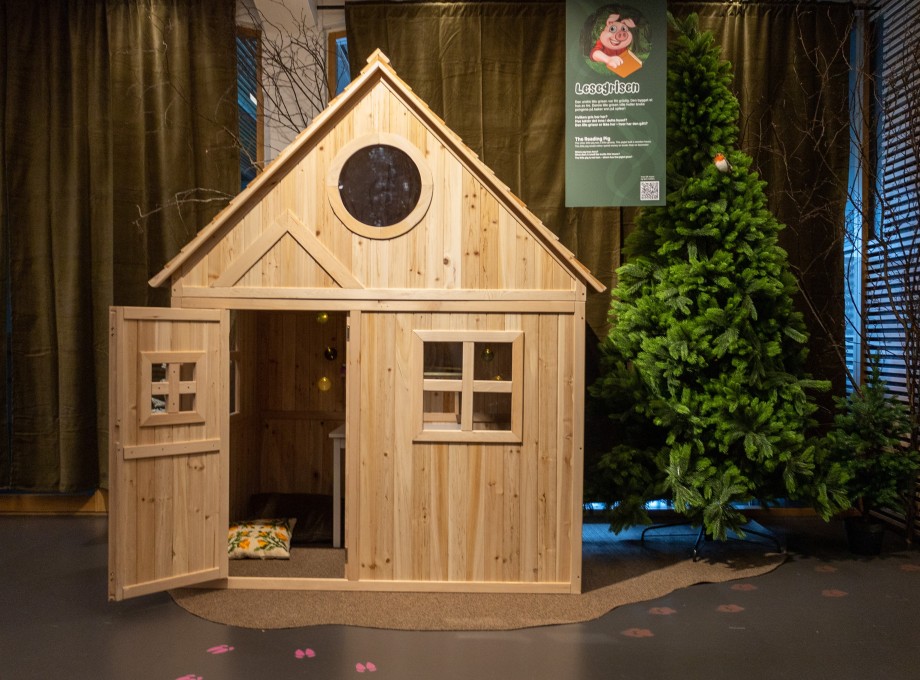
First time in Norway, and possibly first time in the world, the exhibit introduces children to various story-related odours contained in specially designed smell boxes. The boxes are strategically placed around an adventure trail that corresponds to the Three Little Pigs narrative. Some boxes release concrete smells and some abstract ones, some good ones and some bad ones. The odours are of different intensities, and children can decide for how long and how closely they smell them by opening and closing the boxes.
The exhibition is part of the research project Sensory books, which explores the value of olfaction in reading and learning engagement. The research uses participatory research techniques that value the contribution of all community members, including children’s perspectives. Children provide intriguing insights into the value of smell, and in this exhibition, children are encouraged to use their imagination to interpret the smells and connection to the story. We selected The Three Little Pigs story, as it provides a clear narrative with an important moral: hard work and perseverance pays off at the end. We shortened and adapted the narrative with a less dark ending, and we also gave it a modern twist - the clever pig builds a solid house with chocolate on the stove, while the lazy pig spends time on colouring nails. So that there are several entry points to the story, we provided the story in visual and audio formats. The story text and QR codes for the recorded dramatized version, are displayed on the exhibition panels above each of the piglets’ houses.
The exhibition has gone on display on the 14th of June and will be open throughout the summer. The interactive exhibit draws on the expertise of several project partners, whose enthusiasm and creativity are reflected in the final display. The team put together a highly colourful and interactive exhibition featuring the piglets’ houses in the woods. When children start the adventure trail, they are tasked to find the three piglets and follow the story path with a printed map and the pigs’ footsteps on the floor. There is also a drawing area where they can put colours to the drawings of pigs and houses. The recordings of the wolf’s huffing and puffing sounds come from the loudspeakers. Children need to walk around, touch and physically engage with the exhibit to get the most out of it. Thus, although the emphasis is on the olfactory sense, the exhibition engages all senses.
Given the flexibility and portability of the olfactory boxes and a relatively modest budget, there are plans for replicating the exhibition in other countries and locations within the Rogaland region. It is hoped that children, alongside their grown-ups, develop new perspectives on a traditional fairy tale and what it means to follow a story with their nose.
This exhibition is a collaboration between the Learning Environment Center at the University of Stavanger, Vitenfabrikken and Sandnes library. The smell boxes were produced by Lotte Meeuwissen in collaboration with International Flavors & Fragrances (IFF).
Text by Natalia Kucirkova
About the exhibition
Bibliography
Overview of published articles in connection with the Sensory Books project

The significance of children’s olfactory experiences in a Norwegian kindergarten: an olfactory researcher-practitioner collaboration
Abstract: This study is a researcher-practitioner action inquiry which was used to explore children’s sensory experiences with a focus on the sense of smell (olfaction). We critically considered the early childhood theories that positioned children's sensory learning within equitable, socially just early childhood approaches and connected them to an action inquiry approach. The data comprise a systematic documentation of the odours experienced by children in the classroom, an olfactory log of the kindergarten space as well as children’s ‘smellmaps’ from outdoor ‘smellwalks’. We interpret children’s olfactory experiences and reflect on the ways in which the multi-sensory approach to literacy might extend the field’s understanding of the multi-dimensional ways in which educational researchers and practitioners can cultivate their joint inquiries in early childhood education. We present implications for adopting an olfactory researcher-practitioner collaboration in early childhood and conclude that such an approach exemplifies a sensorially sensitive early childhood curriculum.
Children’s Olfactory Picturebooks: Charting New Trends in Early Childhood Education
Abstract: Converging global trends (digitization, globalization, datafication) have influenced all aspects of children’s literacies, including children’s picturebooks. The recent turn towards embodied, affective and sensory literacies, stimulated our interest in multisensory picturebooks that engage all children’s senses, including the sense of smell (olfaction). Olfactory children’s picturebooks demand new forms of literary conversations, which capitalise on unique properties of odours and integrate these with stories. Drawing on a systematic search of children’s picturebooks about, and with, smell, in paper-based and digital formats, we identified three principal ways in which olfaction is currently embedded in children’s picturebooks: 1, as an add-on to depiction of objects (including foods, plants) and places, 2, as a device to introduce humour into a story, and 3, as an engagement tool for children’s active participation in the story. We mobilise Sipe’s (2008) concept of seven constituting elements in children’s picturebooks to describe how current olfactory picturebooks apply the elements in their design and make recommendations for future development of children’s olfactory picturebooks. Reflecting on the generative potential of literary theories and olfactory power to stimulate children’s non-linguistic embodied interactions with picturebooks, we propose some extensions to the current olfactory picturebook landscape.
The importance of sensorial and spatial aspects in family reading at home: Insights from a national survey in Norway (pdf)
Abstract: Purpose: The study investigated the relationships between spatial, multisensorial, and structural factors in family reading routines. Materials: 1001 survey responses and 926 open-ended answers of parents of 3- to 6-year-olds living in Norway, were analysed. Results: Parents who reported having a reading routine with their child valued more highly the spatial aspect of reading than parents who didn’t have established reading routines at home and fathers valued the spatial aspect more than mothers. Highly educated parents valued more the visual sensorial aspect of the reading experience and described the book’s visual appearance as salient for prompting reading conversations. The auditory aspects of reading were perceived negatively, while child’s haptic engagement was rated as motivating for children’s book interest. Conclusion: Parents have a hierarchical perception of the role of senses in children’s reading and place a high value on the place where they read with their child. These aspects need to be integrated into future SBR studies and home interventions.
Digital Edible Literacies: Ephemeral and Highly Affective
Abstract: Digital edible literacies (DEL) are a new media phenomenon that has recently surfaced in social media but has not been examined in scholarly literature before. I exemplify the entanglements of food, media, and children's stories in three DEL exemplars shared on a private blog, Instagram, and connected Meta channels. Drawing on a genre analysis, I position DEL within affective theories and connect them to the concept of ephemeral and material affect. I argue that the ephemeral materiality of DEL expands children's literacies with new temporal relationships that exemplify the sensory dimensions of affect in literacy. This theoretical expansion is important to facilitate understandings of the complex affective qualities of new literacy ecologies.
Multisensory Reading in Early Childhood: Systematic Review with Theoretical Guidance for Human Development Studies
Abstract: Our systematic qualitative analysis advances the field of human development with an integrative review of sensory research in children’s reading of books and e-books. Based on a systematic literature review of 35 papers, we qualitatively synthesise multi-disciplinary literature concerned with children’s sensory development and the activity of reading. We map the studies’ characteristics, including their methodological designs and primary theoretical concepts (embodiment and materiality). We highlight empirical research gaps and lack of literature attention particularly for critical engagement with sensorial research. We find notable terminological discrepancies across qualitative and quantitative studies and lack of attention to the developmental aspects of children’s sensory reading and its dynamic interaction with books’ affordances. Our theoretical contribution lies in identifying the emerging area of multisensory m(ai)cro research as a future agenda for studies of children’s reading, which we support with a terminological guide and a conceptual framework.
The explanatory power of sensory reading for early childhood research: The role of hidden senses
Abstract: Sensory reading refers to reading that engages all six of the human senses – vison, hearing, touch, gustation, olfaction and proprioception. The author proposes that increased attention be paid to the three ‘hidden’ senses of gustation, olfaction and proprioception to advance innovative reading studies. She articulates the problematic of visually dominated multimodal research and print–digital media comparison studies, and extends the reading field to sensory reading that is not tied to a specific medium or mode of engagement but mediated by individualised sensory stimuli. This cross-disciplinary discussion of sensory reading opens up a new vista for affective literacies and integrates the tensions that emerge between psychological and new media studies concerned with material, ephemeral and embodied reading. This approach refines Rosenblatt's transaction theory and contributes new insights into materiality, ephemerality and the embodiment of reading, which dominate contemporary reading studies.
Children's stories and multisensory engagement: Insights from a cultural probes study (pdf)
Abstract: This study builds on child-centred early education models that emphasise active listening to
children’s voices and follow participatory research methods to accommodate children’s expressions. We used the cultural probes method with eleven Norwegian 4-5-year-olds to elicit children’s storytelling and multisensory engagement. The children were encouraged to tell a story using open-ended art-making materials provided in a “story box”. Children’s stories were analysed according to their structural elements with The Social Relationships in Children’s Stories (SRCS) tool, and in relation to the intensity of children’s engagement of their six senses (vision, hearing, touch, smell, taste and proprioception) during the activity. The SRCS analysis showed that children’s stories centred on real characters performing commonly encountered acts, mostly in rural settings (e.g., ‘a man pushing a tree’ or ‘A mother and a baby relaxing in the forest’). Children engaged their senses selectively, in a sequence of different levels of intensity, with the visual and haptic engagement being the most intensively engaged senses during the story-tellings. Children’s real-life stories that engage the hidden senses (olfaction, taste and proprioception) could enrich the methods and design of future education studies.
BBC News Brasil - Why do scientists defend textbooks on paper
Experiment protocol - Exploring the sense of smell in digital book reading (pdf)
Abstract: This paper outlines the background and design, and their rationale, for conducting a small-scale experiment to examine the effect of olfactory stimulation on children’s reading outcomes. The theoretical underpinnings of the study and its significance for the reading field are outlined, followed by a detailed description of the study procedure, design, measures, and instruments. Sixty-six Norwegian children will be recruited to participate in shared book reading sessions with a specially designed digital olfactory book. We test the hypothesis that olfactory-enhanced reading increases children’s engagement in the reading activity and through this engagement, will increase their vocabulary learning, story recall, and overall interest in reading and smell. The study has important implications for children’s reading, olfaction media research, and design studies.
Incorporating smell into children's museums: Insights from a case study in Norway
Abstract: We report on how we integrated smell into the clas-sic children's story ‘The Three Little Pigs’ to enhance a public children's museum exhibition. The study em-ployed Wenger's (1998) social theory of learning as its conceptual framework. It aimed to enhance children's sensory experience in a local Norwegian museum through a collaboration between academia and the in-dustry. We used five abstract smells that were included in five wooden boxes and strategically placed around an adventure trail inside the museum (science factory). In this article, we ref lect on the exhibition choices and findings, and recommendations for future children's exhibitions combining odors and narrative
Olfactoscapes in Malawi: Exploring the smells children like and are exposed to in semi-urban classrooms
Abstract: Moving beyond the “canned” lens on literacies dominant in contemporary literacy studies in Malawi, this study connects theoretical perspectives on sensory and critical literacies to original empirical data on children’s lived “olfactory literacies”. We focus on situational and locally experienced odours in two classrooms in semi-urban Malawi. We present findings from interviews and drawings with 25 children who shared their olfactory preferences with the local researcher. Children’s views were supplemented with the researcher’s and teachers’ evaluations of the olfactory qualities of their classroom environments. Our study advances the field by being the first to unite theoretical provocations on sensory literacies in global child research with critical and empirical insights into children’s local olfactoscapes
Tracing the smells of childhoods with an olfactory research inquiry
Abstract: This paper proposes a multi-method olfactory inquiry to document the rich ways in which children's sense of smell is embodied and embedded in an interplay of senses and socio-spatial relationships. I approach olfaction as a conceptual strategy and connect it to socio-material and socio-spatial theories to illustrate the ways in which close empirical attention to olfaction can provide new insights into children's sensory experiences. An olfactory research inquiry rests on traditional (e.g. SmellMaps and SmellLogs) and speculative (e.g. Ododata and Olfactoscapes) olfactory techniques that invite adults’ and children's agentic responses to odours through relational, dynamic, and non-linguistic modes. As a critical sub-methodology of sensory inquiries, olfactory inquiry can help us re-think normative, homogenizing, mind-body relations in early childhood research and practice.
Parent–child shared reading of scratch-and-sniffbooks:the communicative affordance of olfaction
Abstract: This study extends the research on shared book reading (SBR) byspecifically examining the role of smell in parent–child SBRsessions observed at home. Drawing on qualitative methods, weanalysed the verbal engagement of ten Norwegian families andtheir three tofive-year-olds reading an olfactory book (thescratch-and-sniffbookPeter Follows His Nose). We followed socio-semiotic theorisations (Kress and Van Leeuwen2002), to criticallyevaluate the role of olfaction as a communicative resource in SBR.We outline the principal ways in which smell fulfils threelinguistic metafunctions during adult–child SBR with olfactorystorybooks: the interpersonal function of signalling individualinterests, the textual function of creating a dialogic space and theideational function of revealing divergent interpretations. Wepropose that olfaction can be seen as a semiotic mode in SBR,which similarly to colour, has distinct grammar and systematiccommunication properties, with unique multimodal qualities.
Children’s early reading through the sense of smell: a typology ofolfactory engagement Abstract: We investigated adult–child shared book reading of olfactory books thatstimulate the sense of smell through scratch-and-sniffsurfaces. Weobserved ten adult–child dyads reading olfactory books at home anddocumented the characteristics and quality markers of their olfactoryengagement. Drawing on the principles of learning sciences and socio-cultural learning theories, we propose a Typology of OlfactoryEngagement that brings to the fore the potential of actively engagingthe sense of smell during shared book reading. We outline how theTypology of Olfactory Engagement can serve as a basis for futurestudies exploring adult–child interaction in home learning environments.
Book Review: Consumable reading and children’s literature: Food, taste and material interactions Abstract: If you never heard of edible books, consumable or edible reading before, the chances are that you will devour Ilgım Veryeri Alaca’s new book “Consumable Reading and Children’s Literature, Food, taste and material interactions”. In 10 chapters, Alaca takes readers on a journey through children’s literature and literacy studies with a fresh look: the ways in which taste and consumption play a role in children’s reading. The author’s take on edible reading combines a historical perspective (children’s literature examples from the sixteenth to twenty-first century) with technological innovations in the modern human-food interaction industry. This combination, together with rich examples from her own designed prototypes of edible children’s stories, allows Alaca to make a strong case for an alternative reading future.
Fostering children’s agency in their learning futures: Exploring the synergy of generative AI and sensory learning Abstract: The discourse surrounding the potential educational transformation brought about by generative AI has largely neglected the sensory aspect of learning. In this position paper, I emphasize the significance of sensory studies and their theoretical foundations of embodiment and multimodality as catalysts for novel perspectives on the intersection of AI and the future of education. I delve into the question of whether generative AI serves as a precursor to a new literacy or merely arises as a consequence of ongoing theoretical advancements in contemporary literacy studies. I argue that the concept of agency, which includes both personal and social aspects, should be central to recognizing the importance of sensory learning as an emerging paradigm in reimagining learning futures.
Parent–child shared reading of scratch-and-sniff books: the communicative affordance of olfaction Abstract: This study extends the research on shared book reading (SBR) by specifically examining the role of smell in parent–child SBR sessions observed at home. Drawing on qualitative methods, we analysed the verbal engagement of ten Norwegian families and their three to five-year-olds reading an olfactory book (the scratch-and-sniff book Peter Follows His Nose). We followed socio-semiotic theorisations (Kress and Van Leeuwen 2002), to critically evaluate the role of olfaction as a communicative resource in SBR. We outline the principal ways in which smell fulfils three linguistic metafunctions during adult–child SBR with olfactory storybooks: the interpersonal function of signalling individual interests, the textual function of creating a dialogic space and the ideational function of revealing divergent interpretations. We propose that olfaction can be seen as a semiotic mode in SBR, which similarly to colour, has distinct grammar and systematic communication properties, with unique multimodal qualities.
Children’s multisensory experiences in museums: how olfaction interacts with color
Abstract: This case study was designed to engage children’s sense of smell through a story-related museum exhibition. Children’s responses to the exhibition, with particular attention to their olfactory perceptions of the odors at the exhibition, were solicited through researcher-child interviews and children’s drawings. Responses from 28 children (girls N = 14, boys N = 14) aged between 4.5–8 years were analyzed after they visited the exhibition using the cross-modal association and multisensory theories. Interview data showed that dark (brown and black) colors elicited children’s negative olfactory associations for both positive and negative odors. Children’s drawings did not seem to make references to the odors at the exhibitions but rather their preferences for the different story characters. We theorize about the associations between smell and colors in children’s responses and distil some key learnings for multisensory museology.
News related to the project
Presented abstract at Nordic conference
Radel James Gacumo, on behalf of the Sensory Books project, participated in the Nordic Educational Research Association ...
Findings from Sensory Books project presented at the ECRO XXXIII conference
Dr Laura Speed, Assistant Professor at Radboud University and the project Advisory Board Member, presented findings from...
Initiating multisensory reading research collaborations between Turku and Stavanger
In the months of August and September, professor Natalia Kucirkova had the pleasure to visit the University of Turku as ...
Sensory Books project gathering autumn 2022
Interdisciplinary and cross-sectoral team members from across Europe gathered for a project meeting to discuss the lates...
A visit to the Sensory Books Project Team from Turkey
I am Selim Tosun, a research assistant and Ph.D. student from Ankara University Child Development Department in Turkey...
Sensory Books team gathering
On the 16th of August, the Sensory Books team held their first group gathering after the summer holidays. It was a momen...











